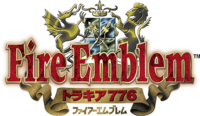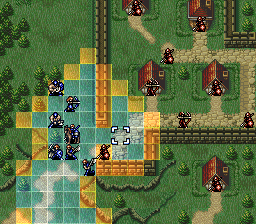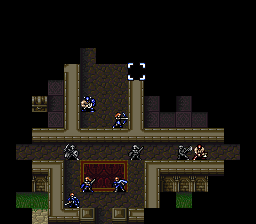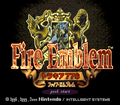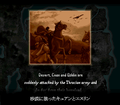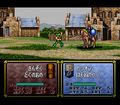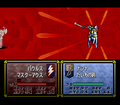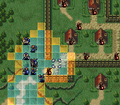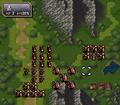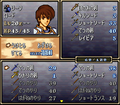| Site News |
|---|
| Warning: This wiki contains spoilers. Read at your own risk! Social media: If you would like, please join our Discord server, and/or follow us on Twitter (X) or Tumblr! |
Fire Emblem: Thracia 776
| ||||||||||||||||
| ||||||||||||||||
| ||||||||||||||||
Fire Emblem: Thracia 776 (Japanese: ファイアーエムブレム トラキア776 Fire Emblem: Thracia 776) is a turn-based strategy role-playing game released in 1999 for the Super Famicom, exclusively in Japan. It is the fifth game installment in the Fire Emblem series, the third for Super Famicom, and is the final game in the series by creator Shouzou Kaga before he left Intelligent Systems. Originally released in 1999 through the Nintendo Power flash cartridge–writing service, it received a formal Super Famicom cartridge release in early 2000.
Thracia 776 is a midquel to its predecessor, Fire Emblem: Genealogy of the Holy War, set entirely in Jugdral's Thracian Peninsula during the year Grann 776; this places it approximately before and during the sixth, seventh, and eighth chapters of Genealogy of the Holy War. It stars Leif, a playable character in the second generation of Genealogy of the Holy War, and details his revolutionary struggle against the Grannvale Empire's occupation of the Munster District. While Thracia 776 fundamentally tells the same story about Leif depicted in passing in Genealogy of the Holy War, there are some minor changes to the events of the prior game.
Plot
Background
In the aftermath of the Battle of Belhalla in Grann 761, almost the entirety of the continent of Jugdral fell under the domination of Grannvale, now an empire headed by Emperor Arvis. The Munster District was subjugated by Thracia following the deaths of Prince Quan of Leonster and his wife Ethlyn in the Aed Massacre, forcing the Leonster knight Finn and Princess Lachesis of Nordion to flee Leonster with Quan's infant son Leif; however, shortly after its capture of the District, Thracia was defeated by Grannvale and forced to cede control of the Munster District to Grannvale's House Friege, becoming a servant state to Grannvale.
Leif's expedition
For the following thirteen years, Leif was raised by Finn and Lachesis while on the run from the Grannvale forces hunting him, along with Lachesis's daughter Nanna; they eventually settled in Fiana, a remote Thracian village, under the protection of its leader Eyvel and her Fiana Freeblades. In Grann 776, while Leif and Finn were absent on a mission with the Freeblades, Fiana was invaded by Raydrik, the Duke of Munster in Grannvale's occupation, who abducted Nanna and Mareeta, Eyvel's adoptive daughter. In response, Leif set out with the Freeblades to enter Munster and rescue Nanna and Mareeta.
During his travels north, Leif encountered August, a Bragi priest also travelling to Munster, who joined up with Leif's group for the journey. Their first target was Fort Kelbeth, a small Munster/Thracia border fort regarded as "the place more terrifying than Hell" by the locals for its role in perpetuating child hunts. August left Leif's group to continue his journey alone when Leif initiated the battle, revealing his knowledge of Leif's true identity. Although Leif's group successfully seized Kelbeth, their success was cut short by the appearance of Raydrik, who used Nanna's life to ensure Leif's surrender. Leif, Eyvel and Lifis were arrested by Raydrik and taken away to Munster, while the rest of the group disbanded and scattered.
Captivity and escape
Leif and Lifis were imprisoned in a dungeon in the bowels of Munster Castle, while Eyvel was taken by Raydrik to participate in gladiator battles. While in captivity, Leif met fellow captives Fergus and Karin, while Lifis earned the loyalty of a small band of imprisoned bandits. The dungeon was soon invaded by the Magi, a group of freedom fighters led by Prince Ced of Silesse, who set about freeing its many prisoners. Ced entrusted his four companions to assist Leif in escaping Munster and forming a liberation army, staying behind to continue the fight himself with his remaining Magi forces.
With the Magi's assistance, Leif broke out of the dungeon into the main castle, where Nanna and Eyvel were fighting in an arena under the observation of Raydrik and his benefactor, Veld of the Loptr Church. Following Eyvel's successes in the arena, Raydrik introduced a new challenger: Mareeta, now controlled by the malevolent power of the Shadow Sword. By the time Leif and the Magi unlocked the arena's exit to free them, Eyvel had been turned to stone by Veld's dark magic, forcing them to leave her behind as they escaped Munster.
Quest for Tarrah
Upon fleeing Munster Leif quickly moves south ahead of Raydrik's pursuing forces. Leif, begrudgingly accepting August's advice to request aid from Thracia, flees to Meath and are placed under protection by Hannibal, renowned general of Thracia. Coincidentally, several of Leif's allies who had been patrolling Munster's outskirts planning to rescue Leif, are captured by Hannibal's security due to their suspicious behavior. Leif gives Hannibal an alias and says that he and his allies were arrested for their opposition to the child hunts.
Leif tells Hannibal that he is headed for Tarrah and Hannibal frees his captured allies and sends Carrion, a knight under his tutelage, with him. They make for Tarrah through the mountains west of Meath. During their journey Leif regroups with Dagdar's bandits and meets with Leonster refugees. Carrion also informs Leif that Hannibal did not fall for his alias and is aware of his status as the lost prince; Hannibal's wishes for liberation from the Empire are the same as the people's. Leif's journey to Tarrah grows in importance when he learns from the refugees's contact at Tarrah, Glade, that the city will be under siege from the Empire soon.
The journey to Tarrah is long; Leif has to pass through Fort Dandrum, clashing with Kempf and meeting Reinhardt's younger sister Olwen. Leif also encounters the Dandelion Bandits who subsequently ally themselves with the Fiana Freeblades.
Leif barely arrives before the Empire's full assault, and slips into the city among the fighting. He and his forces attempt to defend the city but they and the city's defenses are far outmatched. Arion, the prince of Thracia, flies into the city and meets with Linoan, the mayor. Arion convinces her and Leif's forces to flee the city under the promise that the city will come under Thracia's protection.
Leonster's liberation and aftermath
Having fled Tarrah, Leif's forces come to the agreement to liberate Leonster and then head for Munster. However, there were two options to Leonster, one suggested by Dryas and one by August. Dryas claims it is important that they fight openly so that they may inspire the people, while August suggests they use guerilla tactics and stay hidden. It is up to Leif to decide; Dryas's path takes the groups along the coast and straight through the Empire's checkpoints while August's takes them through a Loptrian-infested forest.
Regardless, Leif's forces arrive at Munster and and proceed to attack it. Heading the oversight of Munster is Gustaf. Gustaf, using their families as bargaining chips for their loyalty, has a legion of Leonster knights attack Leif's forces. Leif is able to convince them to stand down after freeing their families and liberates Leonster.
Shortly after freeing the castle, a desperate woman from Ulster begs Leif to rescue the rebels that attempted to repel the Empire. Leif agrees to help Ulster, though he would soon come to learn that this was a grave error.
Both August and Dryas attempt to convince Leif to not intervene; they remind him that his current victories against the Empire were purely due to their mistakes and that they cannot face them head-on. Leif still insists on helping Ulster; Dryas offers to lead the opening forces and tells August to stay with Leif and to follow with their own assault in the morning.
The next morning comes and Leif's half of the forces depart to assist Dryas's. However, they receive the grim news that Dryas fell in battle, his accompanying forces have scattered attempting to flee, and the Empire's full army is retaliating. Leif and his allies then retreat back to Leonster castle and are trapped in a siege for the next six months. They are barely able to hold out in time for Seliph's liberation army to arrive and cause the Empire to flee. Leif and Seliph agree to regroup at Munster and part ways.
Return to Munster
This section has been marked as a stub. Please help improve the page by adding information.
Gameplay
Compared to Genealogy of the Holy War, Thracia 776 returns to a conventional Fire Emblem series mold in its gameplay, featuring a large number of smaller, more tightly-focused chapters and a broader cast. Among English-speaking Fire Emblem communities, Thracia 776 is widely regarded as the most difficult and unforgiving title in the series, matched in its difficulty only by Fire Emblem: Radiant Dawn, owing to both the pressure placed upon the player by several unique mechanics and its challenging map layouts.
Stat changes
Thracia 776 added some unique stats, many of which have not returned. The action stat, or "movement stars", gives units a chance of being able to move again after ending their turn, depending on how many stars they have. The follow-up critical multiplier is a hidden value which multiplies a unit's critical hit chance on the second attack when they follow-up attack an enemy. Both of these stats are set in stone and cannot be modified by the player in normal gameplay. The fatigue stat is a value which increases for all units (except Leif) for performing actions in a battle. Once their fatigue exceeds their HP, they are worn out and cannot participate in the next chapter. If a unit is not deployed in a chapter, their fatigue will reset to 0.
The game also made changes to stats seen in other games. Leadership makes a return here, but this time it gives a hit and avoid boost to all units in the same affiliation, depending on the total number of leadership stars from the units deployed in the map. The resistance stat, which normally acts as a unit's defensive stat against magical attacks, is entirely absent in Thracia 776. Instead, this role is taken on by the magic stat, in addition to the stat's usual role of determining offensive magical power. The game also introduced the constitution stat to the series, providing units with a way to mitigate how much their weapons' weight slows them down in battle. Unlike later games, constitution has its own growth rate, allowing it a chance to increase in Level Ups. Similarly, units can also grow movement through leveling up in this game, although the growth rates are extremely low.
Weapon levels
- Main article:
Weapon level
While Genealogy of the Holy War introduced lettered weapon levels themselves, Thracia 776 implemented the form they would take for the rest of the series. Weapon levels are no longer static and pre-determined based on class and Holy Blood. Instead, they can be increased through ongoing use of the weapon or staff, which accumulates weapon experience and increases the weapon level.
Skills
- Main article:
Skills
The skills system remains mostly the same as in Genealogy of the Holy War, introducing no new skills; the Follow-Up and Critical skills have been removed, with the functions for determining follow-up attacking and critical hit execution now the same as the rest of the series as opposed to depending on the presence of the skills. Some of the skills have had their effects or activation method changed, however. Thracia 776 introduced a set of one-use items to teach a select collection of skills to any playable unit, replacing the skill rings of its predecessor.
Fog of war
- Main article:
Fog of war
Another mainstay mechanic introduced by Thracia 776 was fog of war, a weather state which hinders the battlefield's visibility as the player's army fights in dark or foggy conditions. When fog of war is in effect, allied units have a limited range of vision and cannot see anything outside of it, creating a state of uncertainty and caution. Enemies are invisible until they walk into the player's range of vision, or until a playable unit approaches one. Vision range can be temporarily expanded using torch items or staves, and Thieves and Thief Fighters inherently have a much higher vision range than other classes. Later games would adjust fog of war to allow the player to see the rest of the map's topography outside their vision range, hiding only enemy positions.
Rescue and capture
- Main articles:
Rescue (command) and Capture
Thracia 776 introduced the rescue mechanic to the series, allowing units to rescue their allies of lower constitution to protect them from further harm or remove them from the area, at the cost of penalties to their own stats. Exclusive to Thracia 776 is the capture mechanic, an offensive variant of rescuing in which units can overpower and seize enemies rather than outright killing them, then steal their weapons and let them go or simply keep holding onto them, necessary to recruit some units.
Dismounting
- Main article:
Dismount
Dismounting makes its final appearance as a mechanic in Thracia 776, in a more robust form than its predecessors. Mounted units are required to dismount from their horse, pegasus or wyvern in order to fight indoors, and are allowed to do so at will when outdoors; this removes their vulnerabilities to effective weapons and decreases the effect of terrain for horse-riders, but lowers their stats and alters their usable weapons until they become mounted again.
Characters
- Main article:
List of characters in Fire Emblem: Thracia 776
Thracia 776 features a total of 52 playable characters. However, in a given playthrough the player can only have 47 characters at maximum, as the player is required to choose between, either explicitly or implicitly through split chapter routes, five choices of which character to recruit: Olwen or Ilios, Sleuf or Miranda, Shannam or Misha, Amalda or Conomor, and Ced or Saias.
Chapters
- Main article:
List of chapters in Fire Emblem: Thracia 776
Thracia 776 features a total of 35 chapters in the game's entirety: 27 normal chapters and eight side quests, introducing the concept of side quests to the series. In a single playthrough, the player will tackle between 25 and 33 chapters, as the game features a pair of alternate routes midway through the game which comprise two chapters each before rejoining into a single story at Chapter 18. Side quests are accessed by completing secondary objectives in prior chapters, such as ensuring the safe escape of non-player characters from the map, or preventing villages from being destroyed.
Development
Thracia 776 was released in two forms. Its first release was for the Nintendo Power service, as a digitally distributed game which could be downloaded onto a special flash memory Super Famicom cartridge, the "SF-Memory Cassette", for a lower price than a standard ROM cartridge. This initial Nintendo Power release was accompanied by the Thracia 776 Deluxe Pack, a special-edition bundle containing a pre-written copy of the game, a cloth map of the Thracian Peninsula, a VHS short promotional film called The World of Fire Emblem, and a set of two pegasus and wyvern plush toys.[2] It was later released the next year as a proper Super Famicom cartridge release. Thracia 776 was the last Super Famicom game to receive a proper cartridge release, but not the last officially released Super Famicom game: Metal Slader Glory: Director's Cut was released exclusively on Nintendo Power in November 2000, ten months after the cartridge release of Thracia 776.
Game credits
- Game Design & Scenario: Shouzou Kaga
- Super Advisor: Kentarou Nishimura
- Program Chief: Tohru Narihiro
- System Program: Takafumi Kaneko
- CP Program: Chikara Yamamoto
- Effect Program: Takanori Hino
- Event Program: Ryuichirou Kouguchi
- Graphic Chief: Masahiro Higuchi
- Character Graphic: Sachiko Wada, Yuka Hongou
- Battle Animation: Ryou Hirata, Maki Takemori
- Map Design: Junko Umehara
- Character Design: Mayumi Hirota
- Scenario: Masayuki Horikawa
- Sound Create: Yuka Tsujiyoko
- Sound Create & Sound Program: Atsuko Matsumoto
- Sound Support: Kenichi Nishimaki
- Art Work: Taeko Kaneda, Fujiko Nomura, Yasuo Inoue
- Publicity: Yuusuke Kitanishi
- Special Thanks: Masatoshi Okuno, Takaya Fujii, Super Mario Club
- Producer: Takehiro Izushi
Reception
Owing to its distribution through the Nintendo Power system and its release falling well into the Nintendo 64 era, Thracia 776 holds the distinction of being the worst-selling Fire Emblem game in the Japanese market, having sold only 106,108 units as of 2002.[3]
Fan translation
- Main article:
Fan translation § Fire Emblem: Thracia 776
The predominant fan translation patch for Thracia 776 was the work of Shaya. The patch fully translated the game's script, but many menus and gameplay segments were left untranslated and in an incomplete state. It was last updated by Shaya in 2008.
In September of 2018, a new fan translation project was announced called Project Exile, headed by Cirosan, which aimed to translate the entirety of Thracia 776's menus and story. The patch was released on May 31st, 2019, having achieved its goal of a full translation.
The patch discontinued development as of January 2020[4] (at the cost of the Sound Room and minor Heroes localization changes), but the latest 1.04 patch is still currently available for download.
In December of 2019, another patch named Lil' Manster, originally known as Project Exile - Editor's Cut, was released. Headed by Miacis, one of the lead editors of Project Exile, Lil' Manster uses Project Exile as a base but includes several tweaks such as a revised script that updated character names to match Heroes, a fully translated sound room, and improved skill and item descriptions. The patch also includes some quality-of-life changes such as the ability to see what item a unit has equipped at a glance, a weapon experience display, and the ability to reposition units on the preparations menu, a feature that did not exist in the original version of Thracia 776. Lil' Manster is currently under active development; the latest version, v1.07, was released on January 14, 2021.[5]
Trivia
- This is the last Fire Emblem game to be designed by Fire Emblem series creator Shouzou Kaga.
- This is the first Fire Emblem game to feature fog of war maps, side quest chapters, and a formal Sound Room.
- Along with Genealogy of the Holy War, Thracia 776 is the only game in the series which existed as of 2008 to not be referenced at all in Super Smash Bros. Brawl; every other game in the series which existed at the time has some degree of representation, whereas Genealogy and Thracia do not.
- Sachiko Wada has stated on her Twitter that she owns a copy of the Thracia 776 Deluxe Pack that was a company gift to her; it has a serial number of 0000.[6]
Etymology and other languages
| Names, etymology, and in other regions | ||
|---|---|---|
| Language | Name | Definition, etymology, and notes |
| English |
Fire Emblem: Thracia 776 |
As of Fire Emblem Awakening. The title refers to the date and setting of the game, the Thracian Peninsula in the year Grann 776. |
| Japanese |
ファイアーエムブレム トラキア776 |
Officially romanized as Fire Emblem: Thracia 776. |
| Spanish |
Fire Emblem: Thracia 776 |
As of Fire Emblem Awakening. |
| French |
Fire Emblem: Thracia 776 |
As of Fire Emblem Awakening. |
| German |
Fire Emblem: Thracia 776 |
As of Fire Emblem Awakening. |
| Italian |
Fire Emblem: Thracia 776 |
As of Fire Emblem Awakening. |
Gallery
Screenshots
Still from the game's opening depicting the Aed Massacre.
Nanna attacks Paulus with the Lands Sword.
A gathering of several groups of enemy units.
Thracia's pitch-black fog of war.
Accessing the convoy.
The game's unlockable Sound Room; Thracia 776 was the first game in the Fire Emblem series to have a conventional sound room.
References
- ↑ 1.0 1.1 1.2 1.3 Fire Emblem: Thracia 776 Release Data for SNES, GameFAQs, Retrieved: March 30 2015
- ↑ ファイアーエムブレム トラキア776 デラックスパック, hepokoknight, Published: July 7, 2010, Retrieved: March 30, 2015
- ↑ University of Japan Copyright Center, 日本ユニ著作権センター/判例全文・2002/11/14d 3, Translan, Published: November 14, 2002, Retrieved: March 30, 2015
- ↑ Cirosan, [1], Romhacking.net, Published: January 26, 2020, Retrieved: April 1, 2021
- ↑ Miacis, [2], Serenes Forest, Published: January 14, 2021, Retrieved: April 1, 2021
- ↑ "あと一緒に発掘したトラキアの限定版!会社から頂いたのでシリアル番号が0000 (I also discovered this Thracia limited edition with it! Because the company gave it to me, it has the serial number 0000.)" — Sachiko Wada, [3], twitter.com, Published: May 23, 2016, Retrieved: December 25, 2017
External links
- Fire Emblem: Thracia 776 official Japanese website
- Fire Emblem: Thracia 776 Wii Virtual Console website (Japanese)
- Fire Emblem: Thracia 776 Wii U Virtual Console website (Japanese)
- Fire Emblem: Thracia 776 New Nintendo 3DS Virtual Console website (Japanese)
- Fire Emblem: Thracia 776 Fire Emblem Museum section (Japanese, archived by the Wayback Machine)
| Fire Emblem series | ||||||||||||||||||
|---|---|---|---|---|---|---|---|---|---|---|---|---|---|---|---|---|---|---|
|
